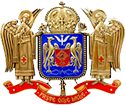The data concerning this period are rather scarce. However, the continuity of the Christian life is confirmed by the archaeological discoveries: six churches in a chalk mountain in Basarabi, county of Constanta, certainly a monastic settlement (dating from the 9th -11th centuries, according to certain historians from the 4th -12th centuries), foundations of two churches in the north of Dobrudgea, one in Niculitel (10th -12th centuries), another one in Garvan (former Dinogetia), from the same period. Several crosses and even cross moulds were discovered in various parts of the country, beyond the Prut river, too. The foundations of a church were discovered in Dabaca, about 30 km north-west of Cluj-Napoca (10th -11th centuries), and some others under the Catholic churches in Alba Iulia and Prejmer, country of Brasov, etc.
These discoveries are not only indubitable evidence on the continuity of the Orthodox Romanians in these territories, but also certain proofs of the necessity of some Romanian bishops.
After the invasion of Transylvania by the Hungarian Catholic kingdom (11th - 13th centuries) the so-called “counties” (Bihor, Alba, Hunedoara) were set up instead of the old Romanian political units. The same happened to the Romanians’ religious structures; Hungarian Catholic dioceses were set up instead of the Orthodox dioceses. So, once the “county” in Bihor was set up, with the residence in Biharea, a Latin diocese was created instead of the Orthodox one, that would soon be moved to Oradea, where it remained until more recently, which is also confirmed by some of the Hungarian historians. The seat of Alba county was established in Alba Iulia, where a Roman Catholic diocese was created and which still exists today, instead of the Orthodox one. The Catholic diocese of Morisena (Cenad) was created by king Steven the Saint of Hungary, in 1038, after conquering the city from prince Ohtum or Ahtum (it was also there that Latin monks were brought, in the Orthodox monastery of Saint John the Baptist). So, the Catholic dioceses in Transylvania have been set up on the very places of the old Orthodox episcopal or chorepiscopal sees from Biharea (Oradea), Alba Iulia and Morisena - Cenad. The phenomenon concerning the replacement of some Orthodox churches and monasteries with Catholic ones can be seen also in other parts of Transylvania.
The religious organisation of the Romanians survived in spite of the policy of Catholicization waged by the kings of Hungary, many times instigated by the pope himself. For instance, a letter of pope Inocentius III to the Archbishop of Calocea, in 1205, mentioned an Orthodox diocese “on the estate of knyaz Balea’s sons”. This diocese could have been either round Bihor or round Hunedoara, where knyazes with this name ruled, some of them founders of churches.

